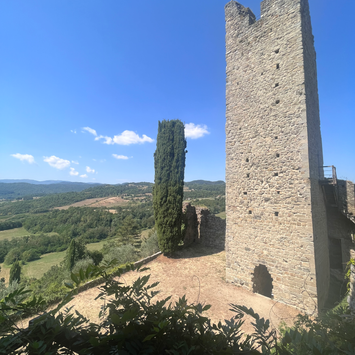
Castello di Romena
The castle is located near Pratovecchio, nestled amidst the beautiful countryside and offers panoramic views of the surrounding landscape. It was originally built as a defensive fortress, but over the centuries, it has undergone various renovations and transformations. Today, it stands as a picturesque reminder of Italy's medieval past.

Opening hours
April
Friday to Sunday and Public Holidays
10:00 a.m. - 1:30 p.m. / 2:30 p.m. - 6:00 p.m.
1 to 5 May
10:00 a.m. - 1:30 p.m. / 2:30 p.m. - 7:00 p.m.
May - June
Friday to Sunday and Public Holidays
10:00 a.m. - 1:30 p.m. / 2:30 p.m. - 7:00 p.m.
July - August
Everyday
10:00 a.m. - 2:00 p.m. / 3:00 p.m. - 8:00 p.m.
1 to 15 September
Everyday
10:00 a.m. - 1:30 p.m. / 2:30 p.m. - 7:00 p.m.
16 to 30 September
Friday to Sunday
10:00 a.m. - 1:30 p.m. / 2:30 p.m. - 7:00 p.m.
October - 3 November
Friday to Sunday and Public Holidays
10:00 a.m. - 1:30 p.m. / 2:30 p.m. - 6:00 p.m.
A brief history of Castello di Romena
Located in the modern municipality of Pratovecchio Stia, the Castle of Romena is one of the most magnificent monumental castles of the Guidi Counts of Casentino. It is situated on a hill 626 meters above sea level and has a view on the Arno River. You will find three large fortified towers, and various sections of the three concentric fortified walls at different levels, which bear witness to the different construction phases the castle underwent between the eleventh and fourteenth centuries, all remnants of its former grandeur.
The castle was built by the Marquises of Spoleto, most likely in the eleventh century, and experienced a major period of growth after the Guidi Counts acquired it in the twelfth century. During the thirteenth century, it, along with the castles of Porciano and Poppi, achieved its peak of architectural beauty. It became the location of the Florentine municipality after the Guidi Counts sold it to the Republic of Florence in the middle of the thirteenth century.
At the end of the 1700s, the castle was put up for public auction and was subsequently purchased by the Goretti de' Flamini family, who still own it today. In the early twenteeth century, specifically in 1902, the poet Gabriele d'Annunzio stayed with the Goretti Counts and wrote much of *Alcyone* there. After restorations in the mid-1950s, the castle took on its current architectural form, remaining one of the most significant castle monuments in Casentino and Tuscany.
Today, Castello di Romena stands as a testament to Italy's medieval past, offering visitors a glimpse into the region's rich history and cultural heritage. Its picturesque setting, combined with its historical significance, makes it a popular destination for tourists exploring the Tuscan countryside.







